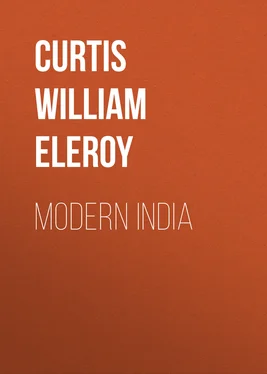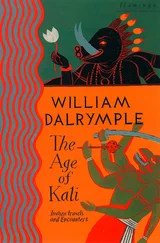William Curtis - Modern India
Здесь есть возможность читать онлайн «William Curtis - Modern India» — ознакомительный отрывок электронной книги совершенно бесплатно, а после прочтения отрывка купить полную версию. В некоторых случаях можно слушать аудио, скачать через торрент в формате fb2 и присутствует краткое содержание. Жанр: Путешествия и география, История, foreign_edu, foreign_antique, foreign_prose, на английском языке. Описание произведения, (предисловие) а так же отзывы посетителей доступны на портале библиотеки ЛибКат.
- Название:Modern India
- Автор:
- Жанр:
- Год:неизвестен
- ISBN:нет данных
- Рейтинг книги:4 / 5. Голосов: 1
-
Избранное:Добавить в избранное
- Отзывы:
-
Ваша оценка:
- 80
- 1
- 2
- 3
- 4
- 5
Modern India: краткое содержание, описание и аннотация
Предлагаем к чтению аннотацию, описание, краткое содержание или предисловие (зависит от того, что написал сам автор книги «Modern India»). Если вы не нашли необходимую информацию о книге — напишите в комментариях, мы постараемся отыскать её.
Modern India — читать онлайн ознакомительный отрывок
Ниже представлен текст книги, разбитый по страницам. Система сохранения места последней прочитанной страницы, позволяет с удобством читать онлайн бесплатно книгу «Modern India», без необходимости каждый раз заново искать на чём Вы остановились. Поставьте закладку, и сможете в любой момент перейти на страницу, на которой закончили чтение.
Интервал:
Закладка:
All visitors who intend to remain in Bombay for any length of time are expected to call upon the governor and his wife, but it is not necessary for them to drive out to Malabar Point for such a purpose. On a table in the reception room of the government building down-town are two books in which you write your name and address, and that is considered equivalent to a formal visit. One book is intended exclusively for those who have been "presented" and by signing it they are reminding his excellency and her excellency of their continued existence and notifying them where invitations to dinners and balls can reach them. The other book is designed for strangers and travelers, who inscribe their names and professions, where they live when they are at home, how long they expect to be in Bombay and where they are stopping. Anybody who desires can sign this book and the act is considered equivalent to a call upon the governor. If the caller has a letter of introduction to His Excellency he can leave it, with a card, in charge of the clerk who looks after the visitors' book, and if he desires to see the governor personally for business or social reasons he can express that desire upon a sheet of note paper, which will be attached to the letter of introduction and delivered some time during the day. The latter, if he is so disposed will then give the necessary instructions and an aide-de-camp will send a "chit," as they call a note over here, inviting the traveler to call at an hour named. There is a great deal of formality in official and social life. The ceremonies and etiquette are modeled upon those of the royal palaces in England, and the governor of each province, as well as the viceroy of India in Calcutta, has his little court.
A different code of etiquette must be followed in social relations with natives, because they do not usually open their houses to strangers. Letters of introduction should be sent with cards by messengers or through the mails. Then, if the gentleman to whom they are addressed desires, he will call at your hotel. Many of the wealthier natives, and especially the Parsees, are adopting European customs, but the more conservative Hindus still adhere to their traditional exclusive habits, their families are invisible and never mentioned, and strangers are never admitted to their homes.
Natives are not admitted to the European clubs. There is no mingling of the races in society, except in a few isolated cases of wealthy families, who have been educated in Europe and have adopted European customs. While the same prejudice does not exist theoretically, there is actually a social gulf as wide and as deep as that which lies between white and black families in Savannah or New Orleans. Occasionally there is a marriage between a European and a native, but the social consequences have not encouraged others to imitate the example. Such unions are not approved by public sentiment in either race, and are not usually attended with happiness. Some of the Parsees, who are always excepted, and are treated as a distinct race and community, mingle with Europeans to a certain degree, but even in their case the line is sharply drawn.
The native district of Bombay is not so dirty nor so densely populated as in most other Indian cities. The streets are wider and some of them will admit of a carriage, although the cross-streets are nearly all too narrow. The houses are from three to five stories in height, built of brick or stone, with overhanging balconies and broad eaves. Sometimes the entire front and rear are of lattice work, the side walls being solid. Few of them are plastered, ceilings are unknown and partitions, for the sake of promoting circulation, seldom go more than half way to the top of a room. No glass is used, but every window has heavy blinds as a protection from the hot air and the rays of the sun. While our taste does not approve the arrangements in many cases, experience has taught the people of India how to live through the hot summers with the greatest degree of comfort, and anyone who attempts to introduce innovations is apt to make mistakes. The fronts of many of the houses are handsomely carved and decorated, the columns and pillars and brackets which support the balconies, the railings, the door frames, the eaves and architraves, are often beautiful examples of the carvers' skill, and the exterior walls are usually painted in gay colors and fanciful designs. Within doors the houses look very bare to us, and contain few comforts.
The lower floor of the house is commonly used for a shop, and different lines of business are classified and gathered in the same neighborhood. The food market, the grocery and provision dealers, the dealers in cotton goods and other fabrics, the silk merchants, the shoe and leather men, the workers in copper and brass, the goldsmiths, jewelers and dealers in precious stones each have their street or quarter, which is a great convenience to purchasers, and scattered among them are frequent cook-shops and eating places, which do not resemble our restaurants in any way, but have a large patronage. A considerable portion of the population of Bombay, and the same is true of all other Indian cities, depends upon these cook-shops for food as a measure of economy and convenience. People can send out for dinner, lunch, or breakfast at any hour, and have it served by their own servants without being troubled to keep up a kitchen or buy fuel.
There are said to be 6,000 dealers in jewelry and precious stones in the city of Bombay, and they all seem to be doing a flourishing business, chiefly with the natives, who are very fond of display and invest their money in precious stones and personal adornments of gold and silver, which are safer and give more satisfaction than banks.
You can see specimens of every race and nation in the native city, nearly always in their own distinctive costumes, and they are the source of never-ending interest–Arabs, Persians, Afghans, Rajputs, Parsees, Chinese, Japanese, Malays, Lascars, Negroes from Zanzibar, Madagascar and the Congo, Abyssinians. Nubians, Sikhs, Thibetans, Burmese, Singalese, Siamese and Bengalis mingle with Jews, Greeks and Europeans on common terms, and, unlike the population of most eastern cities, the people of Bombay always seem to be busy.
Many enterprises usually left for the municipal authorities of a city to carry on cannot be undertaken by the government of India because of the laws of caste, religious customs and fanatical prejudices of the people. The Hindu allows no man to enter his home; the women of a Mohammedan household are kept in seclusion, the teachings of the priests are contrary to modern sanitary regulations, and if the municipal authorities should condemn a block of buildings and tear it down, or discover a nuisance and attempt to remove it, they might easily provoke a riot and perhaps a revolution. This has happened frequently. During the last plague a public tumult had to be quelled by soldiers at a large cost of life because of the efforts of the government to isolate and quarantine infected persons and houses. These peculiar conditions suggested in Bombay the advantage of a semi-public body called "The Improvement Trust," which was organized a few years ago by Lord Sandhurst, then governor. The original object was to clear out the slums and infected places after the last plague, to tear down blocks of rotten and filthy tenement-houses and erect new buildings on the ground; to widen the streets, to let air and light into moldering, festering sink holes of poverty, vice and wretchedness; to lay sewers and furnish a water supply, and to redeem and regenerate certain portions of the city that were a menace to the public health and morals. This work was intrusted to twelve eminent citizens, representing each of the races and all of the large interests in Bombay, who commanded the respect and enjoyed the confidence of the fanatical element of the people, and would be permitted to do many things and introduce innovations that would not be tolerated if suggested by foreigners, or the government.
Читать дальшеИнтервал:
Закладка:
Похожие книги на «Modern India»
Представляем Вашему вниманию похожие книги на «Modern India» списком для выбора. Мы отобрали схожую по названию и смыслу литературу в надежде предоставить читателям больше вариантов отыскать новые, интересные, ещё непрочитанные произведения.
Обсуждение, отзывы о книге «Modern India» и просто собственные мнения читателей. Оставьте ваши комментарии, напишите, что Вы думаете о произведении, его смысле или главных героях. Укажите что конкретно понравилось, а что нет, и почему Вы так считаете.












